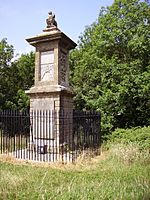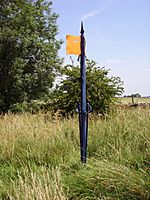Battle of Lansdowne facts for kids
Quick facts for kids Battle of Lansdowne |
|||||||
|---|---|---|---|---|---|---|---|
| Part of First English Civil War | |||||||
 The battlefield today with Sir Bevil Grenville's Monument |
|||||||
|
|||||||
| Belligerents | |||||||
| Commanders and leaders | |||||||
| Lord Hopton + Sir Bevil Grenville † Colonel John Giffard |
Sir William Waller | ||||||
| Strength | |||||||
| 2,000 horse 4,000 foot 300 dragoons 16 guns |
2,500 horse 1,500 foot Unknown number of guns |
||||||
| Casualties and losses | |||||||
| 200-300 killed 600-700 wounded |
20 killed 60 wounded |
||||||
The Battle of Lansdowne was a major fight during the First English Civil War. It happened on 5 July 1643, near the city of Bath in southwest England. In this battle, the Royalist army, led by Lord Hopton, managed to make the Parliamentarian army retreat. The Parliamentarians were led by Sir William Waller. Even though the Royalists won, they lost many soldiers and ran low on supplies. Lord Hopton himself was hurt, which made it hard for his army to keep fighting.
Contents
Why Did the Battle of Lansdowne Happen?
By the end of May 1643, Lord Hopton's Royalist army had taken control of most of southwest England. They joined forces with the Earl of Hertford and began moving east. This area was controlled by the Parliamentarians. Sir William Waller's army was in Bath, trying to stop the Royalists from moving further.
Royalists Advance Towards Bath
On 2 July 1643, the Royalists captured a bridge at Bradford-on-Avon. The next day, 3 July, small fights broke out near Claverton. These skirmishes also happened at Waller's positions south and east of Bath. Waller then moved his army to a very strong spot on Lansdowne Hill. This hill was northwest of Bath. Meanwhile, the main Royalist army moved north through Batheaston to Marshfield.
Scouting Lansdowne Hill
On 4 July, Hopton's forces reached Lansdowne Hill. They were surprised by how strong Waller's position was. The Royalists decided to pull back about 5 miles (8 km) northeast to Marshfield. Waller's cavalry tried to chase them, but the Royalist rearguard fought them off.
How the Battle of Lansdowne Unfolded
The main battle began early on 5 July. Waller moved his forces to the north end of Lansdowne Hill. There, his soldiers quickly built rough walls to protect themselves. He also sent some of his cavalry to attack Hopton's guard posts.
Early Skirmishes and Royalist Attack
The Parliamentarians managed to scare off some Royalist cavalry that were not well-led. This caused an alarm, and Hopton's entire army quickly got ready. They began to move west until they could see Waller's position. The two armies fought in small, undecided skirmishes for two hours. Then, Hopton tried to pull his troops back.
Waller once again sent his horsemen and dragoons (soldiers who rode horses but fought on foot) to attack the Royalist rearguard. This time, they defeated the Royalist cavalry. However, the Royalist foot soldiers stood firm. Hopton's army then turned around and eventually defeated the Parliamentarian cavalry in a confused fight.
The Charge Up Lansdowne Hill
Hopton's Cornish foot soldiers (infantry) began to advance without waiting for orders. So, Hopton finally ordered a full attack on Lansdowne Hill. As they charged up the very steep slopes, Hopton's cavalry suffered greatly. Many of them panicked and fled, with 1,400 running as far as Oxford.
Under the leadership of Sir Bevil Grenville, Hopton's Cornish pikemen (soldiers with long spears) stormed Waller's protective walls. At the same time, Royalist musketeers (soldiers with guns) moved around Waller's forces through the woods on both sides. Sir Bevil Grenville was badly wounded in hand-to-hand fighting. Parliamentarian horsemen tried to counter-attack but were driven back. Waller's foot soldiers fell back to a wall at the top of the hill. From there, they kept firing their muskets until it got dark. During the night, they quietly left the hill. To trick the Royalists, they left burning matches on the wall, making it seem like they were still there.
What Happened After the Battle?
The day after the battle, a Royalist cart carrying gunpowder exploded. Lord Hopton was injured and temporarily blinded by the blast. Because they had lost their gunpowder and most of their horsemen, the Royalists could not fight another battle right away.

Meanwhile, Waller had gone back to Bath. He received more soldiers and was ready to attack again. Hopton's army, feeling defeated, retreated to Devizes. Their situation was so bad that Waller, who was an old friend of Hopton's, even offered him a place to stay in Bath. Hopton, however, refused.
A Cornish officer who was at the battle wrote that Waller was "... the best shifter and chooser of ground when he was not Master of the field that ever I saw". This means Waller was very good at picking the best places to fight, even when he wasn't winning.
The place where the battle happened is marked by a monument. It is dedicated to Sir Bevil Grenville, who died after the battle in Cold Ashton Rectory.
Images for kids



